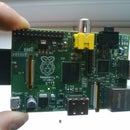Introduction: Arduino Stepper Motor and Servos Shield - AW GCSE Board
This instructable will show you show to build an Arduino shield which can be used to control 3 servos and 1 stepper motor using 4 potentiometers. You will need:
access to a laser printer/cnc router/etching chemicals
7 x 3 pin 3.5mm terminal blocks
2 x 2 pin 3.5mm terminal blocks
2 x 8 pin stackable headers
2 x 6 pin stackable headers
1 x 8 pin chip socket
1 x L293D motor driver chip
optional: access to a laser cutter
soldering iron
solder
something to shape the board, eg disc sander
access to a laser printer/cnc router/etching chemicals
7 x 3 pin 3.5mm terminal blocks
2 x 2 pin 3.5mm terminal blocks
2 x 8 pin stackable headers
2 x 6 pin stackable headers
1 x 8 pin chip socket
1 x L293D motor driver chip
optional: access to a laser cutter
soldering iron
solder
something to shape the board, eg disc sander
Step 1: Etch the Board
Attached are the Eagle files for the schematic and PCB layout of the board. It is single sided, and should be etched or milled.
Step 2: Drill the Board
The next step is to carefully drill the holes for the components. Below is a picture of the drilled board. Drilling before shaping means we can align the board for laser engraving.
Step 3: Laser Etch the Board
This step is optional, but provides the shape of the board and some useful text on the top of the board. Below is the 2D design file, and also a DXF. The hardest part of all of this project is lining up the laser. I drew a line along the line of the holes that you should have drilled, and used the laser cutter to follow the path without cutting, so I could see if it was in the right place. When you are happy, engrave the writing onto the surface of the board (I could recommend testing the settings on an old PCB).
Step 4: Shape the Board
You should now have an outline engraved onto the top of the board. As the picture in the previous step shows, either disk-sand the edges, or use some other method, but shape the board to the outline. I used a small drill bit cutting disk for the finer details.
Step 5: Populate the Board
The next step is easy, solder on the components. It's fairly obvious where they go, but if not, refer to the schematic/pcb in an earlier step, or the photo below.
Step 6: Code
I will post the code, when i've tested it, however, for the moment I will just give you the vital info. I would recommend modifying the Servo Pot example code. A0, A1, A2 and A3 are the potentiometer inputs. D7, D6 and D12 are the servo connections. On the L293D, pin 2 is D10, pin 7 is D9, pin 15 is D11 and pin 10 is D8. If you need any help, just comment below.
Step 7: Response!
I am looking for some opinions, as this is my GCSE Technology PCB, as well as being useful otherwise. I would like some opinions about some or all of the following things if you are able:
if you've made it, does it work/problems/general feedback/pics
refinements that could be made
aesthetics/ergonomics - does it look good/is it easy to use
is there any better way of actually manufacturing it?
any other comments
Thank you very much for your time.
if you've made it, does it work/problems/general feedback/pics
refinements that could be made
aesthetics/ergonomics - does it look good/is it easy to use
is there any better way of actually manufacturing it?
any other comments
Thank you very much for your time.

Participated in the
Hack It! Challenge











